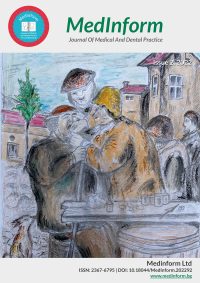Issue Two 2022
2022, Vol. 9, issue 2, (September)
Literature Review
The therapeutic use of botulinum toxin in different oral and maxillofacial conditions
Abstract:
Botulinum toxin A (BTx-A), a neurotoxin isolated from Clostridium botulinum, has been used for the treatment of a wide spectrum of conditions involving muscular spasm and hyperactivity, bruxism, in the management of temporomandibular joint disorders (TMD) related to muscle tension, fatigue, in cases of blepharospasm, strabismus, cervical dystonia, as a migraine preventive treatment etc. The established mechanism of the action of BTA is the inhibition of acetylcholine release from the motor nerve endings resulting in a locally decreased muscle contraction. Although the pathophysiology of myofascial pain remains uncertain, multiple neurologic, myogenous, and psychological theories have been accepted. Further evidence has suggested that the analgesic effects of Botox are mediated through the inhibition of the release of substance P and glutamate, which occurs at a lower concentration than the dose, necessary to produce muscle weakness. It could be used as a therapeutic option in functional recovery from dental, oral and maxillofacial surgery.
Myofascial pain disorders, in most cases, are due to muscle hyperactivity and could include malocclusion, TMJ internal derangement, cervical pain, psychological stressors and parafunctional habits. Patients non-responsive to conservative treatment modalities, even if etiological factors are eliminated, could be a therapeutic challenge to the clinician. The efficacy of trigger point intramuscular botulinum toxin injections in the management of myofascial pain is still controversial. A lot of clinical trials supported the efficacy of BTx-A in reducing the occlusal force and myofascial pain symptoms.
Keywords: botulinum toxin; bruxism; myofascial pain, temporomandibular joint disorders
Authors:
Natali Tomeva; Department of Dental,Oral and Maxilofacial Surgery, FDM-Sofia, Medical University – Sofia.;Elitsa Deliverska; Department of Dental,Oral and Maxilofacial Surgery, FDM-Sofia, Medical University – Sofia.;
Peter Ignatov; Department of Health Care, Faculty of Public Health, Medical University – Sofia.;

